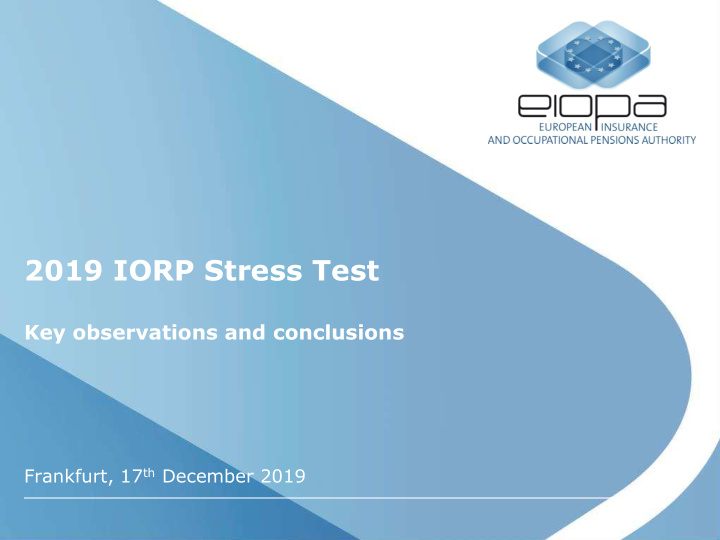



2019 IORP Stress Test Key observations and conclusions Frankfurt, 17 th December 2019
Sample • Participating Member States: over EUR 500 million IORP assets at year-end 2018 • 20 countries: AT, BE, CY, DE, DK, ES, FI, FR, GR, IE, IT, LI, LU, NL, NO, PT, SE, SI, SK, UK o FR participated for the first time o UK did not participate • Coverage: 60% of DB assets, 50% of DC assets o IE did not reach the required coverage • 176 IORPs participated (99 DB, 77 DC) 2
What is this stress test about? • What is the effect of an adverse market scenario on an IORPs’ financial situation? o Impact on investment assets o Impact on members and beneficiaries o Impact on sponsors • What can we learn from the expected investment behaviour after the shock for the financial stability of the sector? • Do IORPs understand the exposures stemming from sustainability/ESG risks in their investments? 3
What was the adverse scenario? • Sudden reassessment of risk premia • Shocks to interest rates higher on short maturities/ increased yields and widening of credit spreads o ‘positive’ effect on long -term obligations, ie discounting effect decreases value of liabilities • One-off, instantaneous and permanent shifts in asset prices relative to end-2018 levels 4
What happened to the assets when applying the shock? • The adverse scenario stressed investment assets: o Would have wiped off almost EUR 250bn in the DB sector in the sample and EUR 16bn in the DC sector in the sample o Loss in values represents well over 2% of the 2018 GDP of the participating countries. DB IORPs DC IORPs 5
What happened to the balance sheet when applying the shock? • Aggregate excess of assets over liabilities: o National methodologies: EUR -180bn o Common methodology: EUR -216bn • Leading to potential, aggregate benefit reductions of EUR 173bn and increase of sponsor support of EUR 49bn 6
What does that mean? • If adverse market scenario would materialise, European IORPs’ financial situation would o be heavily affected in the short term o require financial support by sponsoring undertakings or other security mechanisms o have long-term effects on the future retirement income of members and beneficiaries Excess of assets over liabilities (excl. sponsor support, pension protection schemes and benefit reductions) in baseline and adverse market scenario, % liabilities (excl. benefit reductions) 7
What did we observe in terms of investment behaviour? • IORPs investment behaviour after the shock is expected to o Rebalance to pre-stress investment allocations within 12 months o Exhibit counter-cyclical aspects, yet not without risks Net buying and selling of equity after the shock Bonds Equity Other investments until end-2019 100% 90% 20% 21% 21% (+) (-) (=) 100% 80% 90% 27% 28% 32% 31% 44% 45% 80% 70% 48% 55% 25% 70% 13% 13% 30% 12% 32% 74% 12% 60% 60% 6% 50% 7% 18% 8% 40% 50% 30% 60% 59% 56% 45% 58% 39% 49% 3% 20% 37% 40% 23% 10% 0% (excluding home &… 30% Equities Equities listed Home Euro area (excluding Other developed Equities non-listed US Emerging markets 55% EEA countries 49% 47% 20% home) 10% 0% Pre-stress - end Post-stress - end Post-stress - end 2018 2018 2019 8
What did we observe in terms of integration of ESG factors? • Majority of IORPs are taking steps to identify sustainability aspects and ESG risks for their investment decisions IORPs having in place a process to manage ESG Assessment of ESG impacts on risks and returns of risk, % IORPs the investments, % IORPs 9
What about the IORPs’ carbon footprint? • Investments could be allocated to NACE business sectors and corresponding greenhouse gas emissions Greenhouse gas intensity of IORPs’ equity Greenhouse gas intensity of IORPs’ debt investments by country, kg per EUR value investments by country, kg per EUR value added added 10
What are the take-aways? • Long-term obligations and long investment horizons of IORPs o enable IORPs to sustain short-term volatility and market downturns for longer periods than other financial institutions o arguably require consideration of ESG risks and sustainable financing o call for supervisory monitoring and appropriate supervisory tools to detect adverse market trends and developments with long-term negative effects 11
What does EIOPA suggest to do with those conclusions? • Follow up on the findings: improved reporting of IORP information enables market monitoring and risk assessment: o Particularities of IORPs investment behaviour and investment allocation o Continued low interest/low yield environment • Importance of prudential frameworks to be capable of fairly reflecting sensitivities and exposures on both assets and liabilities 12
When is the next exercise? • Follow-up on the procedural aspects: reducing complexity of the stress test: o Work on methodological framework for stress testing IORPs, starting in 2020 o Extending horizontal approach, assessing DB and DC sectors together • Next exercise expected for 2022 13
Thank you for your attention!
Recommend
More recommend